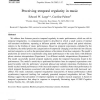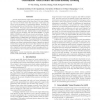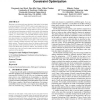115 search results - page 20 / 23 » From Synchrony to Asynchrony |
PODC
2010
ACM
13 years 8 months ago
2010
ACM
We study the computational power of a distributed system consisting of simple autonomous robots moving on the plane. The robots are endowed with visual perception but do not have ...
COGSCI
2002
13 years 6 months ago
2002
We address how listeners perceive temporal regularity in music performances, which are rich in temporal irregularities. A computational model is described in which a small system ...
ICASSP
2011
IEEE
12 years 10 months ago
2011
IEEE
Acoustic event detection (AED) aims to identify both timestamps and types of multiple events and has been found to be very challenging. The cues for these events often times exist...
AVSS
2006
IEEE
14 years 23 days ago
2006
IEEE
Most surveillance and monitoring systems nowadays utilize multiple types of sensors. However, due to the asynchrony among and diversity of sensors, information assimilation how to...
ATAL
2003
Springer
13 years 12 months ago
2003
Springer
We present a new polynomial-space algorithm, called Adopt, for distributed constraint optimization (DCOP). DCOP is able to model a large class of collaboration problems in multi-a...



